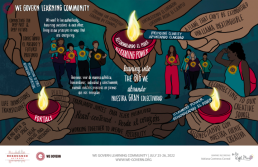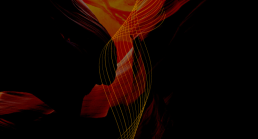Reframing Power and Embracing What is Possible
Lighting the Candle of Liberatory Governance

As phase two of the WeGovern Learning Community winds to a close, participants gathered to reflect on their journey.
This community came together with a shared commitment to practice liberatory governance — and we did. Participants—including Resonance Network, who convened the learning community space but practiced as a participant team—reimagined what governance beyond dominant power structures could look like in our organizations, tribes, networks, and teams.
And what came through as we reflected on the experience was not only the transformations that took shape externally within these groups, but internally among participants as well.
Our choices add up to the world we’re building — and once you feel the power and possibility in choice making and community building from a place of liberation and care, you can’t turn back. We all felt that.
Our commitment to governance practice kindled a deeply felt sense of what is possible.
The process of embracing WeGovern—a set of governance principles rooted in mutual care, dignity, and thriving–in our own lives—helped each of us realize that we have more agency in the choices we make to live from our values than we realized.
Of course, the systems of control and domination we live within want us to believe that power exists outside of ourselves — but the opposite is true. Our choices add up to the world we’re building — and once you feel the power and possibility in choice making and community building from a place of liberation and care, you can’t turn back. We all felt that.
This practice became an affirmation that governance begins with each of us — in the choices we make each day to engage with ourselves, each other, our families, and our communities.
Bringing clarity
Each of us felt this sacred responsibility — an embodied knowing that developed in the practice. We described it as “a bell that can’t be un-rung” or similarly, “a flame that can’t be extinguished.” Once we felt that sense of agency in choice making — and began to witness the ripple effect of transformation in our communities — we couldn’t go back to business as usual.
But the future we are moving toward isn’t completely unknown to us — it lives in our lineage, in the memories of our ancestors, in the wisdom of the land that sustains us, and in the relationships we are building with one another.
Instead, we find ourselves choosing to move into the unknown — away from what has been familiar, and toward what feels whole. The future we are moving toward is unknown — it is unknown to the collective systems we live within that have shaped so much of our lives, profited from limiting our perceptions of possibility, and capitalized on dulling our sense of collective purpose. But the future we are moving toward isn’t completely unknown to us — it lives in our lineage, in the memories of our ancestors, in the wisdom of the land that sustains us, and in the relationships we are building with one another.
Reconnecting to spirit
The sacred responsibility of this way of worldbuilding, the connection to lineage and ancestral memory–bringing the wisdom of what was into what will become–is spirit work. It is work that requires tending to sustain it, but also sustains us. We seek spirit the same way sunflowers seek the sun.
We seek connection to spirit not just to ask for what we want, but to remind us of our humanity, our power, and our clarity in service to a higher purpose–a world where all beings can thrive. And that world is taking shape each day, in the relationships between us. If we are the candles that cannot be extinguished, our connection to spirit and purpose kindles the flame so that we can light other candles.
Claiming power
The flames we tend are a reminder of our power. The power that naturally comes from connection to source and purpose. The organic current of creative energy that flows when we’re in alignment with purpose and care. Despite the ways oppressive systems try to diminish our power, we are transforming ourselves, our communities, and our collective systems.
We claim our power when we see ourselves within the system–when we see and feel the way our agency, our choices can be used to change it. When our individual agency and power becomes collective. We claim our power when we refuse to be separate–from ourselves, from each other, and from the generations that came before and will come after us. When we accept the sacred responsibility of choosing the way we want to be, in alignment with the world we want to live in.
originally published at The Reverb
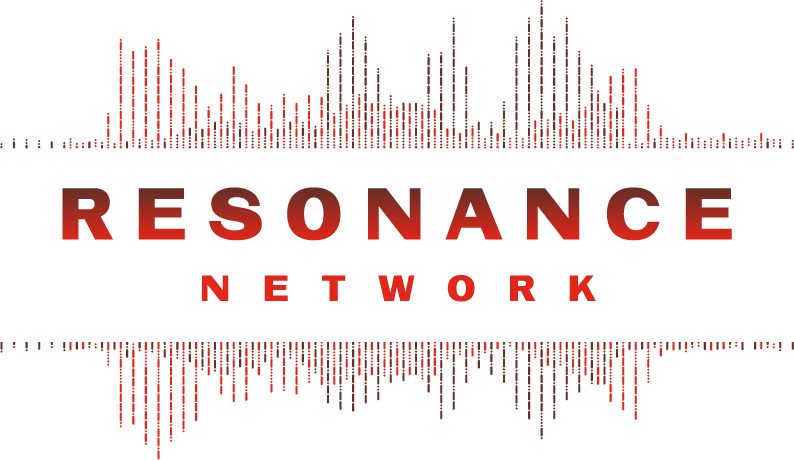
Resonance Network is a national network of people building a world beyond violence.

Network Weaver is dedicated to offering free content to all – in support of equity, justice and transformation for all.
We appreciate your support!
donate in the box above or click here
Applying regenerative practice to systems beyond place — some thoughts
By way of introduction: spiky fruit
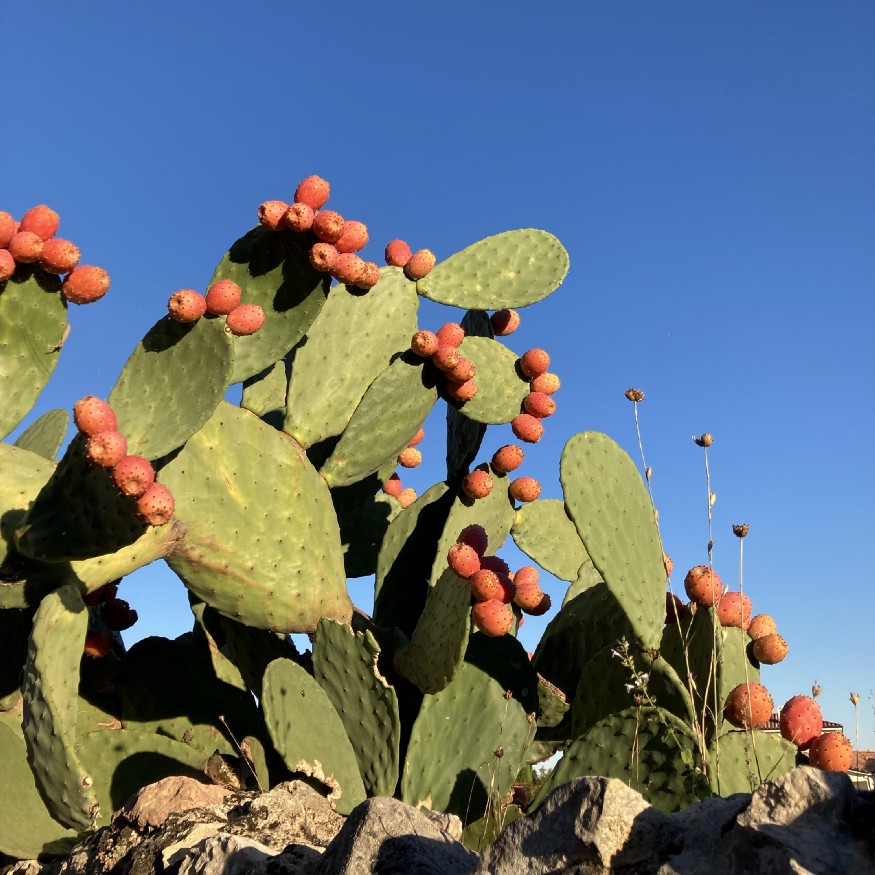
It’s the first of October, and I’ve been writing this piece for over half a year! Yesterday this cactus caught my eye. The spiky leaves and the ripe fruit spoke to me of the necessity to take these unpolished thoughts and offer them up. If handled carefully and peeled, the juicy prickly pear can make a great salad. It’s painstaking and potentially irritating work. The flesh is not as flavorsome as other fruit, but it’s what grows and abounds here and now. So perhaps you can enjoy the thoughts that follow in that spirit!
Rising to the challenge
Our societies and our living planet are struggling to survive with the threat of climate change, mass extinction of species, depletion of the living resources of soil on all our continents — the list goes on. In the face of this regenerative work offers the hope of enabling the extraordinary capacities of living systems to adapt and create the conditions conducive to life.
There is an active community of regenerative practitioners supporting change-makers the world over to work from the principles of living systems in order to revive and evolve the places and the systems they are working with. Living systems are grounded in places, adapting to local conditions and contexts, evolving strategies to thrive in the myriad diversity of environments, from hot deep sea vents, to estuaries where sea and land intermingle, to cloud forests of the tropics, to green ‘deserts’ of grassland. The source of regenerative practice is found in the dynamic relationship of life and place, and the inevitable relationship of people to and within other living entities. People, human societies, are living systems, and as such we are deeply connected to the places we live and depend upon.
However, as human societies have evolved over the last few hundred years into a global civilization, and many of the challenges we face are playing out on the scale of the whole planet, regenerative practitioners are called to find ways to apply our living systems approaches to activities that seem disconnected from “place”. When we look to change international business supply chains, when we design digital services, when we think about what sustainability means for huge global retail corporations, how can we bring regenerative practice to bear? In an age where the shift to online working has been accelerated through the Covid-19 pandemic, and I write this from a co-working space in the south of France as part of a team with people across four continents, how can the potential of life-regenerating work step into and beyond hyper-local “place” as a contribution to a societal shift so needed this decade?
What follows are a few thoughts, deeply influenced by my work and dialogues with Regenesis, Future Stewards and other regenerative practitioners. These thoughts have formed as I apply this practice to the School of System Change, an international endeavour to support change-makers navigate the field and practice of systems change, growing their capacity to work with complexity and uncertainty, and to contribute to great shifts in business, civil society, government, communities and philanthropy.
Disconnected from place?
I deliberately speak of activities that seem disconnected from place. Our human capacity to understand ourselves as disconnected from nature, from living systems, from place, has been honed over several hundred years of Western mechanistic thinking. Those of us who have learnt to understand our world in this way continually develop constructs — both physical and conceptual — that reinforce this premise of separation or non-dependence on life. We build global digital platforms with remote-working teams. We manage supply chains from warehouse to container to truck to logistic platform to supermarket in a complicated chain through multiple built environments made of concrete, metal, tarmac. We speak of dematerialised banking, and have decoupled finance from the “real” economy. We manage agricultural production through sterile seeds and petrochemical fertilisers.
I have learnt to see how all of these activities are nested within the living systems of our planet. The people working behind their screens or their steering wheels are alive, they need food to nourish them that is alive too (or at least was recently!). Our businesses, communities and cities are complex living systems with the same needs and metabolic functions as a forest ecosystem: nourishment for energy, clean water, purification of waste, temperature control… The people and places impacted by “dematerialised” activities may be widespread and seeminging disconnected, however they are indubitably alive, and in many contexts in need of activating their regenerative potential to tackle increasingly difficult issues of physical and mental health, pollution, soil degradation, and adversity.
Pretending that a human activity has no grounding in living systems and places — because of its digital or global nature, because it involves commodities sourced via intermediaries and their warehouses — carries a high risk of creating harmful externalities to the living systems that are inextricably linked to these activities but remain invisible in our designs. This decoupling of our activities from the living systems we operate within perpetuates the deep-seated pattern that has led to the crises we are living into today, from climate change to the global pandemic.
Putting living systems back in the equation isn’t easy work, but it is possible, and deeply rewarding. Where might we start?
I am offering three sets of practices that can support a regenerative outlook, even when working with systems that seem disconnected with place:
- Seeing life in everything
- Working with specificity not generic outcomes
- Starting with the care we hold for our fellow living beings
Seeing life in everything
The first set of three practices are helping me develop my ability to see living entities — people, organisations, places — as alive.
Working with qualities of aliveness
One of the ways I have learned to do this is through noticing three qualities of aliveness (from Regenesis):
- evolution — organic development and unfolding, where things aren’t going to plan, but are moving and adapting to uncertainty and complexity, and there is no going back!
- viability — relational dynamics that are necessary to survival over time, relationships to wider ecosystems, be they food webs or markets or fields of shared endeavour; and
- vitality — the spontaneous expression of life force, uniqueness, purpose and energy that can be felt when a person or an organisation is flourishing
These qualities are interrelated — the vitality of a living system needs nourishment to be viable over time, and continuously adapts and evolves as the world changes around us.
Noticing these qualities helps me engage with living systems — including human systems seemingly disconnected from the living world — as inherently alive. It is also a way into identifying which capacities might need enhancing to ensure ongoing life in these systems.
Changing metaphors
Our mechanistic ways of thinking are deeply anchored in metaphors we use all the time! So I practice changing the metaphors and looking for life-sourced images to describe what’s going on. How might we grow capacity rather than build it? How might we look for nodal interventions rather than leverage points (a node refers to a place in a living entity where many flows come together, whereas a lever is a component in a machine)? How might we seek evolution not scale?
Sometimes the more ecological or metabolic metaphors can seem a bit too hippie, and I don’t always adopt them, however the conscious practice of identifying which paradigm I’m thinking from through the language I employ is very insightful. I have noticed how comfortable it is to revert to terms that imply predictability and the ability to control outcomes! (building capacity, driving change, measuring impact — just some examples) Adopting life-sourced metaphors implies leaning into uncertainty, working with what is emerging, and thinking of what I do as a contribution to wider work.
Looking for connection to place
The third exercise is trying to ground the systems I’m working on in place — even if these places are multiple and seemingly disconnected, like across a supply chain. Reminding myself that life is rooted. That even hydroponic agriculture relies on nutrients that have come from the living earth — somewhere! Our office sites have footprints on the ground, and are situated in complex ecosystems.
Envisaging the ways in which our activities are connected to and dependent upon living places, and then questioning the impacts on the vitality, viability and evolution of these places — at multiple scales — can yield insights both devastating and full of opportunity for change. Devastating because we might notice how much life has been destroyed as we create an inert built environment for ourselves, for example pouring concrete over the earth so that the microorganisms beneath will be disconnected from the flows of water from rain and nutrients and energy released into the soil through plant roots. Full of opportunity because we can amplify the extraordinary qualities of life which will continue to evolve and regenerate, through multitudes of human innovations that work in symbiosis with the living world.
Looking for this connection to place in the history of the organisation is often a good place to start, as the identity and culture — however international in its operations — may well be imbued with the unique characteristics of the ground it sprang up from in the beginning.
Working with specificity not generic outcomes
This set of practices is helping me work with the unique characteristics of the systems I’m involved with to identify differentiated and coherent strategies for action, producing unique and positive outcomes.
I often hear the ask for a definition or catalogue of what might be “regenerative outcomes”. In the face of the crises we’re experiencing, and with the best will in the world to effect positive change, people and organisations want answers, and clear how-tos. I hear the urgency, and the need for simple, actionable responses. However, I am learning to first respond with a set of questions to reach differentiated answers — as living systems are differentiated and there is no one-size-fits-all. The set of questions below can quite quickly lead to answers that in turn will be much more powerful in unlocking life-regenerating processes.
The overarching starting question here is What is the essential characteristic or nature of what we’re working with?
Some of the ways into this question are
- What is the unique purpose of this business or endeavour (which may be deceptively different from the mission statement, being more what is alive in the business as a whole, it’s core pattern that repeats across scales from teams to international operations, and configures this organisation’s contribution to a wider sphere)
- What is the core property of the material / commodity / species we’re working with? How might we work with the inherent properties of aluminum, or cotton, or soap — for example — to work out how these can be expressed in service of life?
- What are living systems like round here? How have they — people, plants, animals, micro-organisms — adapted to the specific living conditions of this place? What might we learn from these strategies?
Starting with the essential characteristics of what we’re working with is a route to seeing the potential that could be expressed if we lifted these up to serve a living world. It can help us be open and curious. We can move beyond the generic plan to “plant trees”, to question which essences, which combination of context-appropriate species, we might encourage in this particular place.
We can go further to understand that if we’re a clothing company, for example, planting trees is all very well but it doesn’t harness the potential of the core of what we do — the living materials, people and identity that are at the centre of our activity. The regenerative contribution of a luxury brand will be distinctly different from that of a high-street clothing brand. Recognising our unique approach, and going beyond market differentiation to putting this in service of the living systems we’re involved with, will highlight practical actions we can take leading to powerful regenerative outcomes.
Starting with the care we hold for our fellow living beings
One of my recent insights about regenerative work is that it stems from a deep care about the world, which taps into vulnerability, and therefore requires a certain kind of intimacy and attention. When we care, we are in relationship being to living being. We can be curious about what is specific about what is happening here and now, we can be empathetic — feeling from the place of the other, we can work with emotional and intellectual intelligence together, bringing our whole selves to the situation at hand.
It’s difficult to talk about how much we care for the living world in situations where everything around us (our office space, the board room, our managerial practices, our scheduling habits) are designed from mechanistic assumptions and “man-made” materials. Paying attention to what is alive, even in these contexts, can require a shift in how we show up and what we are giving our attention to. Put another way, it’s about being as much as doing.
This leads to a new set of questions around the enabling conditions for some of this work:
- How might we let ourselves see our fellow workers, customers, citizens as whole people striving to live nourishing lives?
- How do we move from concern for a statistic (e.g. numbers of mental health-related emergency calls) or worry about a trend (e.g. decreasing yields from ever poorer soils) to care about the living beings — the people, the ecosystems of microorganisms in the soil — we’re so interconnected to?
- What are the qualities of space we might need to tap into this other way of knowing and deciding what to do in the face of the overwhelming challenges we’re facing?
Bringing regenerative practice home
I know I’m a conversational learner, and I thrive in deep conversations and spaces of inquiry around these sorts of questions. I can see how through these collective moments my thinking about the world is evolving, and informing my work in the long term. I also practice micro-experiments to take my thinking into my daily life in a shorter timescale — these range from spending a whole summer without killing a single mosquito as an experiment in respecting the equivalence of life-forms, to fermenting kimchi in my kitchen, to applying the vitality-viability-evolution framework to all sorts of projects, situations and relationships at work and at home through five-minute sketches.
This may not be your way of connecting with aliveness. At an online team meeting a few months back I was struck by the beautiful diversity of situations when people feel most alive — from on a sea shore, to being in crowded public transport. If you invite yourself into a space of caring for the living world for a moment, what is it you notice? And how might you carry that with you into the big, wide world, as a root to help you with your very unique contribution to systems change?
originally published at School of Systems Change
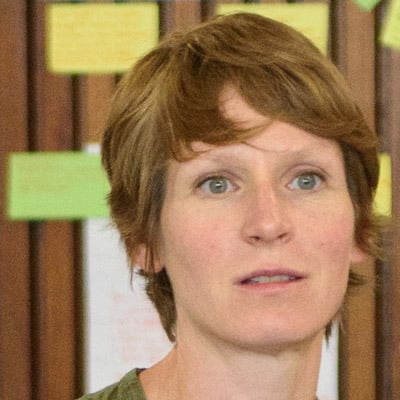
Laura Winn is head of the School of System Change at Forum for the Future. She works to develop the School as a networked organisation that supports change-makers from diverse backgrounds and contexts, providing them with new capabilities to tackle an increasingly complex set of sustainability challenges. Laura's own practice stems from living systems and regenerative approaches, learnt and applied across multiple small-scale and large-scale projects.

Network Weaver is dedicated to offering free content to all – in support of equity, justice and transformation for all.
We appreciate your support!
donate in the box above or click here
Failing Productively in Systems Change: Key Mindsets & Practices
This era of disruption requires us to take on deeper systemic challenges. As changemakers, how do we embrace failure as an inevitable part of the work of shifting complex systems? And how do we detangle it from feelings of fear that prevent us from taking the deep risks needed to advance real change?
We've developed tools, resources, and strategies to purposefully assist people in collectively taking on complex, systemic challenges. Our approach focuses on deepening engagement and building momentum to advance strategy and impact.
In this webinar, CoCreative team members Russ, Heather, and Luzette led a co-inquiry to deepen our shared understanding of productive failure, why it is important to systems change and the key mindsets that need to be challenged to do so.
We're deeply grateful to our friends at Tamarack Institute for hosting this important conversation.
Speakers: Russ Gaskin, Heather Equinoss, Luzette Jaimes and Sonja Miokovic
Download the slide deck we used in this session. We also invite you to explore these links to learn more:
- Read Lisa Attygalle’s paper Creating a Culture of Engagement which explores the fear we might feel when deeply engaging citizens in community change work
- Check out Fail Forward to develop skills in learning from fear of failure
- And get our two-pager on Embracing Failure in Systems Change


Download the "Embracing Failure in Systems Change" resource.
Included:
- Failing Productively in Systems Change webinar
- Failing Productively in Systems Change slide-deck
- Embracing Failure in Systems Change thinking tool pdf
Download HERE
originally published at wearecocreative.com
featured image found HERE

Network Weaver is dedicated to offering free content to all – in support of equity, justice and transformation for all.
We appreciate your support!
donate in the box above or click here
Weaving Networked Action for Systemic Change - A Practical Guide
This short guide synthesizes the practice of weaving for leaders, social entrepreneurs, and facilitators looking for holistic ways to co-create systemic change.
Written by Namrata Arora & Adrian Röbke as members of The Weaving Lab.
Introduction: Systemic Change Towards a Thriving World
We find ourselves in intensifying personal, societal and ecological turbulence. Our societies are transitioning and natural ecosystems are eroding at an alarming rate. We are at a collective choice point: How we act right now will determine if the planet remains livable for humanity and many other species [1].
On the bright side, many are contributing to societies that honor the fundamental interrelation of people and the planet. Now, there is a great need to share power and re-imagine our systems together. We are called to learn our way into a more beautiful expression of being human together.
Since ancient times, communities of people have gathered to resolve issues, share concerns, celebrate, mourn and partake in each other's 'human beingness'. These traditions are rooted in indigenous cultures and continue in many cultures [2]. Based on these lineages, there is a growing body of knowledge that supports emergence through collaboration [3].
Yet, we still lack individual and collective capacities to align across our differences. It is therefore essential to learn how to weave. Weaving entails interconnecting people, projects and places in synergistic and purposeful ways [4]. This short guide introduces you to specific mindsets, skills and practices to catalyze systemic changes.

Weaving in Action - Stories from The Field
To center our exploration of weaving in real life, here are three stories of inspiring weaving in action:
- Fundación Mi Sangre has the purpose to co-create a culture of peace in Colombia. They convene people from the military, government, teachers, parents and youth. For 15 years they created awareness, learning, and innovative practices and were able to impact the lives of 1,5 million people.
- The Bioregional Weaving Labs (BWL) Collective takes collective action across Europe to make climate and biodiversity plans more actionable. They weave their expertise, knowledge, and teams to restore, protect, and regenerate landscapes and seascapes. Through mapping the needs of bioregions, they can address root causes through nature-based solutions.
- Service Space, one of the world’s largest volunteer-run international organizations, believes that small, collective acts can transform the world. Started in 1999, they aim to bring meaning to the front and center of our lives. Service Space connects people from around the world, catalyzing collaboration to spark the spirit of generosity, making the world a better place through meaningful action.
These initiatives have in common that they foster inclusive collaboration, which is enabled through specific weaving ways and practices.
Weaving Ways and Practices
Weavers foster coherent, purposeful and synergistic communities and social ecosystems. Through the use of liberating structures that are grounded in our 'interbeing', they facilitate inclusive conversations, cross-pollinate knowledge and align action [5, 6]. Gathering together in a formal setting is not necessarily weaving. If there is an expression of compassion and interrelatedness of self, others and the planet, weaving is in play. Throughout six years of action research, 300 + weavers from diverse cultures in The Weaving Lab identified four specific ways and practices:
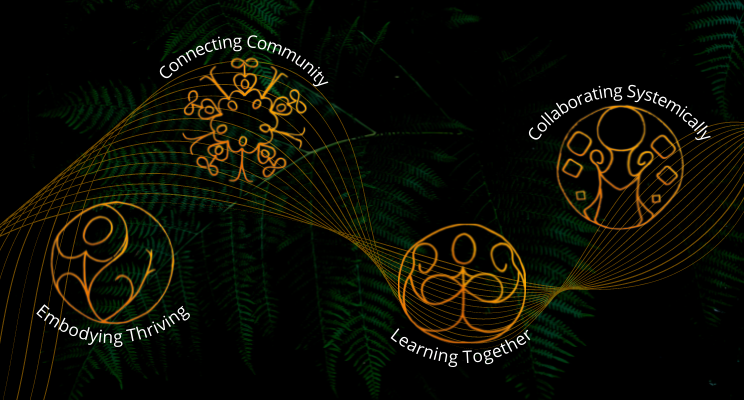
1. Embodying Thriving - Becoming inclined and equipped to thrive through practices that nurture personal, societal and ecological wellbeing.
2. Connecting Community - Creating conditions for diverse and inclusive communities in which people feel belonging and have a shared purpose.
3. Learning Together - Developing processes for cultures of continuous sharing, improvement and experimentation.
4. Collaborating Systemically - Fostering cooperation for strategies that transform systemic mechanisms and mindsets.
Embodying Thriving

Weavers become inclined and equipped to thrive through practices that nurture personal, societal and planetary wellbeing [7]. They embody life-affirming qualities and virtues. Inner and outer development are truly interdependent. Personal well-being includes emotional, physical, mental and spiritual dimensions and our sense of belonging, purpose and contribution. Societal well-being relates to how we create cultures that center on equity, thriving and justice. Planetary well-being refers to the thriving of all species, ecosystems and places. Weavers bring these different layers together in a coherent practice.
Weavers cultivate virtues and steward thriving cultures:
- Cultivating an inner awareness to stay present in uncertain situations.
- Showing up with vulnerability and heart-centered listening.
- Developing compassion for diverse people and beings.
- Being playful and creative in the face of challenges.
- Fostering wisdom through continuous inquiry.
- Embodying resilience in the face of adversity.
Reflection Question: What personal and collective practices to embody thriving more fully do you want to learn?
Connecting Community

Weavers create conditions for diverse and inclusive communities in which people feel belonging and have a shared purpose. They foster trustful, nourishing and dynamic relationships through patience and frequent communication. Sharing personal stories, needs and dreams are great ways to begin. As a solid foundation of trust is developing, people start to feel a sense of belonging. We are woven into an intricate web of life including diverse species and places. It is therefore critical to foster significant relationships with the wider natural world. And, to learn from nature's principles how to participate in diverse ecosystems.
Specific practices:
- Supporting the ecosystem through difficulties, roadblocks and failures.
- Maintaining momentum and direction through continuous alignment.
- Co-creating lived experiences of oneness with the web of life.
- Facilitating differentiated roles and sub-communities.
- Expanding distributed power and decision-making.
- Stewarding a common culture and identity.
Reflection Question: What skills do you want to learn to better support your communities to become more interconnected and aligned?
Learning Together

Weavers steward processes for cultures of continuous sharing, learning and experimentation. Learning is an ongoing process of 'becoming', which takes humility and perseverance. It is therefore essential to adopt a growth mindset, question blind spots and reflect often. Real learning happens when people meet between diverse perspectives and ways of knowing. Weavers, therefore, co-develop community-wide learning values, principles and aspirations. These are the basis for action-learning approaches that are grounded in the coherence of the head, heart and hands. Through constant learning, the ecosystem can remain adaptive and resilient in ever-changing circumstances.
Specific Practices:
- Designing, facilitating and harvesting collective learning experiences.
- Translating and contextualizing dynamic flows of learning.
- Using storytelling and visualizations to communicate.
- Developing reflective and contemplative practices.
- Collecting, synthesizing and evaluating data.
- Creating generative experiences in nature.
Reflection Questions: How can you center a beginner's mindset in your approach to weaving?
Collaborating Systemically

Weavers foster collaborative strategies that transform systemic mechanisms and mindsets. They seek to tackle the root causes of challenges instead of symptoms. This means paying attention to underlying systemic dynamics through sensing interconnections, relationships and energy flows. It is then possible to tackle root causes and leverage points for systems change. Based on these, an ecosystem can then implement targeted interventions. Over time, aligned action can fundamentally challenge and replace dominant institutions, mindsets and structures. So, through synergizing diverse efforts, it becomes possible to move a system towards a more thriving state.
Specific practices:
- Checking the health of an ecosystem and catalyzing continuous evolution.
- Co-creating, adopting and spreading transformative innovations.
- Supporting developmental evaluation to stimulate adaptation.
- Integrating theories of change of diverse collaborators.
- Organizing and resourcing strategies and projects.
- Mapping systems, networks and feedback loops.
Reflection Question: How can you support your collective to address systemic root causes through targeted action?
The Weaving Process ~ Learning from Circle Work
In order to understand how weaving works, we take one of its applications, 'Circle Work' and elucidate the process that it entails [8]. In 'Circle Work', a group of participants who align with an agenda gather together for co-sensing and co-creation, led by a skilled convener, who offers to hold space for emergence using a set of guidelines, a time frame and a purpose as the three guideposts. While ‘Circle Work’ has been around since ancient times, practiced by various indigenous cultures, its more modern applications range from community action to education to employee engagement. Even though the purpose of the gathering may be predefined, however, owing to its emergent nature, the outcomes of the session(s) cannot be predetermined.

The Working of a Circle
'Circle Work' starts with an articulated intention that is driven by a purpose and aligns with a group of potential participants. The circle convener volunteers to be a ‘space holder’ for what might want to emerge from the collective. A circle is situated in a specific moment of time, given a context that resonates with and binds a group of people who might be willing to gather in a space that is earmarked for weaving. This could be a virtual or physical space that is neutral and may provide a sense of safety for free expression.
Various elements which are at interplay in the process of weaving include human elements and non-human tangible and abstract elements. Human elements include the Circle Convenor or Weaver and participants; tangible non-living elements include the physical environment including 'Circle Principles' (guidelines which enable the creation of a safe space for sharing), sound, space layout and intangible elements include time, space, intention and consciousness of all those who are present.
A multitude of factors governs the nature of interplay among these elements making each circle experience unique and irreplicable. When in a circle, participants can be said to experience a transference of consciousness among themselves and with the center of the circle, thus unfolding and giving form to the group's emergent collective intention. It is for this reason that presencing is a key aspect of any weaving. Our individual state of being has a deep impact on what emerges in the collective.
The Flow of Circle Work
The proceedings of a circle start with a brief centering exercise in the form of meditative music or the playing of a singing bowl or the reading of poetry or spiritual text or simply leading participants into a mindfulness activity such as breathwork. Bringing all participants into their presence invokes the sacredness of the space. In a physical setting, the center might be set up as an altar with flowers, water, incense, a lamp and other elements that the host might find appropriate.
This centering is followed by a reminder of the circle principles or guidelines for engaging with the circle. These principles are to be viewed as gentle scaffolding and may be reviewed and revised by all as necessary. They uphold the core values of deep listening, confidentiality, inclusion, respect and authenticity that guide the circle members through their time together.
An open-ended question leads circle participants into the circle, thus setting the stage for the theme that might be pre-decided. Anchoring the circle in an inquiry enables a common purpose to unfold, thus allowing for new insights and action steps to emerge through a shared resonance among participants.
As the circle progresses, participants gain an opportunity to practice deep listening, thus opening themselves to new ways of thinking. Circles cultivate compassion and create a sense of inclusion for all. When convened on an ongoing basis, circles create a feeling of belonging and provide a fertile ground for sustainable change to take roots.
The closing of a circle is marked by a checkout which might be in the form of brief reflections by all or a compassion prayer, wishing well for all. A theme for the next circle might emerge at this point, thus allowing for the circle to ‘remain unbroken’ till the next gathering.
Success Criteria
Embodying gratitude, all participants are encouraged to empty their bowl of expectations and use the opportunity to offer their precious gifts, including deep listening and honoring silence when it is collectively called for.

Various formats of circles or related gatherings, referred to by a variety of names, are now being practiced around the world and signal the onset of a 'movement of movements [9].
Now What? - Our Invitations
1. Deepen your unique style of weaving
The beauty of working collectively is that you inherit your unique niche and synergize your role with that of other weavers. We, therefore, invite you to further experiment and make these practices work in your context.
2. Learn, co-create and spread weaving ways and practices
Together we can further build the field of weaving. This means learning, exchanging ideas and innovating together. So, find and co-create the spaces that nourish your learning.
3. Dive into additional resources, tools and perspectives
There are many articles, books, and guides out there that you can explore. To dive into more specific topics, you can use the hyperlinks in this article. To access further resources, review the references.
We invite you to join us in the inquiry of 'how does one balance the interplay of flow and outcome through the weaving process?' There is no formula for ensuring this balance and this is where the context of the individuals, the collective and the shared intention or purpose play a key role. While emergence is constant, the duration that it takes to accomplish the outcome of a weaving process might vary. There is no endpoint to weaving. We are part of a continuous process of evolution that always evokes new questions, challenges and opportunities.
Conclusion: Cultivating Our Weaving Practice
The Weaving Ways and Practices are an open-ended exploration of making sense of weaving. There is a wide variety of skills to learn and we cannot do that by ourselves. So, we warmly invite you to share your thoughts about this article. It is in the messy field between perspectives and worldviews that we can engage in weaving fully. Let us dream, dare and do everything in our power to co-create a more thriving world. We end with this poetic reflection, hoping it provides you with the inspiration we need to cultivate this work in our world:
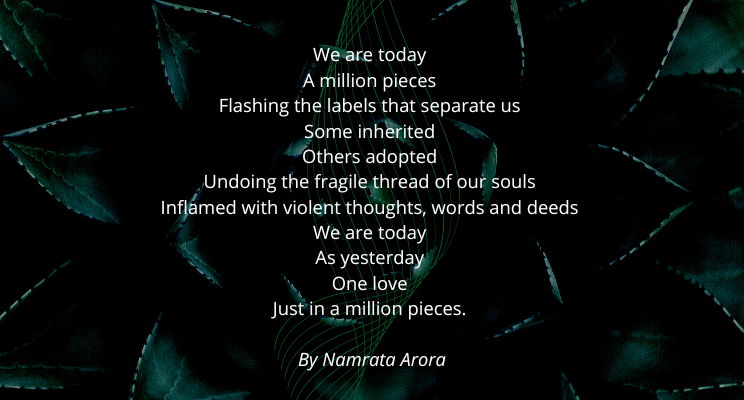
Acknowledgements and Gratitude
We thank every contributor to The Weaving Lab for the countless heart-centered conversations that created the weaving ways of practices. Specifically, we appreciate Tjin Tjoelker, Victoria Haro, Ben Roberts, Ross Hall, Carolina Obara, Kai Brouwer, Robyn Whittaker and Nick Graham for their generous feedback. Lastly, we acknowledge every one of you who is embodying more thriving on the planet, including the land and our non-human kin.
About The Authors

Contact her via: LinkedIn or E-Mail.

Contact him via: LinkedIn or E-Mail.

You can also download a pdf with a link to this guide to save to your personal library by visiting the Network Weaver Resource Page.
Resources
[1] State of the World:
- Climate Change 2022: Impacts, Adaptation and Vulnerability by IPPC
[2] Indigenous Knowledge:
- Sand Talk - How Indigenous Thinking Can Save the World By Tyson Yunkaporta
- Braiding Sweetgrass by Robin Wall Kimmerer
[3] Regenerative Leadership & Networks:
- Designing Regenerative Cultures by Daniel Christian Wahl
- Regenerative Leadership - The DNA of life-affirming 21st-century organizations By Giles Hutchins & Laura Storm
- Leading from the Emerging Future: From Ego-System to Eco-System Economies by Katrin Kaufer and Otto Scharmer
- Impact Networks: Create Connection, Spark Collaboration, and Catalyze Systemic Change by David Ehrlichman & The Converge Network.
[4] Definition and practice clusters by The Weaving Lab
[5] Facilitation:
- The Surprising Power of Liberating Structures: Simple Rules to Unleash A Culture of Innovation by Henri Lipmanowicz and Keith McCandless
- The Art of Hosting
[6] Inner Development:
- Thich Nhat Hanh Interbeing: The 14 Mindfulness Trainings of Engaged Buddhism
[7] Thriving:
- The Age of Thrivability: Vital Perspectives and Practices for a Better World by Michelle Holliday
- Thrive: The Third Metric to Redefining Success and Creating a Life of Well-Being, Wisdom, and Wonder by Arianna Huffington
[8] Hosting Circles:
- The Magic of Circle Work by Jalaja Bonheim
- The Circle Way by Ann Linnea and Christina Baldwin
- A Millionth Circle by Jean Shinoda Bolen
[9] Blessed Unrest by Paul Hawken
Originally published HERE
featured image found HERE

Network Weaver is dedicated to offering free content to all – in support of equity, justice and transformation for all.
We appreciate your support!
donate in the box above or click here
